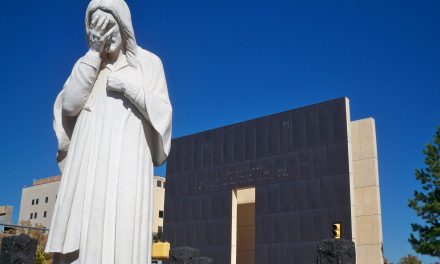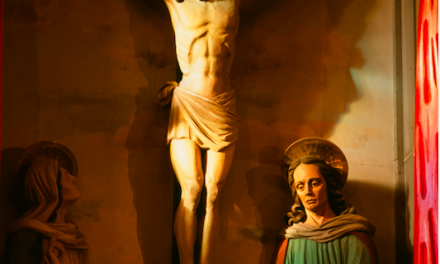The following entry is cross-posted with the Patheos.com book club discussion on the text.
Holy Week is an appropriate time to turn our minds and hearts to the contemplation of the end of all things – to eschatology – as Matthew Levering’s subtle new book, Jesus and the Demise of Death, helps us do. We prepare for participation in the greatest, most beautiful liturgies we have, during the Triduum, culminating in the explosion of light and praise that is Easter. Levering’s book demands much more than a blog post; hence, I simply offer two crucial points, which are essential in his text and in the understanding of Christians, one more academic, the other more pastoral.
Levering’s book, as is typical of his work, is a detailed exposition of how Aquinas is right. In this case, the context is the challenge posed by N.T. Wright’s influential work (which Levering does not seek to dismiss but rather to qualify and reconcile with Aquinas), and its strong criticisms of the (malign) Greek/Platonic influence on traditional Christian views of heaven. It seems to me the heart of this confrontation is Levering’s concern that Wright’s “new creation” is too “active” – too focused on work. He quotes Wright: “There will be work to do and we shall relish doing it.” Then he complains that this “overemphasis [on] the horizontal dimension of glory” and its “description of the enhancement of our skills and talents does not evoke a life utterly ‘beyond all comparison.’ … If we emphasize the renewed material creation and a new set of cosmic adventures, we risk turning eternal life into something quite banal. Who wants to repeat forever, no matter in how elevated a fashion, our earthly experiences of banqueting and evangelization?” (p. 10) Levering is, throughout the book, incredibly charitable to his interlocutors, especially Wright – but this particular moment seems to highlight the concern that drives his work. “Banal”? “Repeat forever”? As an alternative, Wright seeks to defend images like the beatific vision, with its emphasis on seeing, but even more its emphasis on a kind of spiritual participation which truly does stretch beyond our temporal experiences.
On an academic level, what are we to make of this debate? Well, it seems we could make too much of it. For example, Levering offers plenty of descriptions of eternal life that are not “beyond comparison”: the heart of the constructive argument is the development of three “eschatological marks” (apostolic teaching and fellowship, Eucharistic worship, and sharing of possessions) that “mark” both Christ’s passage and our own, and which are fulfilled in eternal life. While the final vision is a matter of “seeing,” Levering also includes images of “hearing” and “moving” (appropriate to a resurrected body – p. 119-20), talks of how the “blessed with be supremely engaged and energized in enjoying God and each other in God” (p. 113), and consistently holds that love is what remains. But what is love without shared activity? “Engaged and energized” sounds like activity. “Knowing and loving God the Trinity…will be our task,” he says (p. 125), but if this is a shared task, could it not be a matter of feasting, singing, and the like? At the same time, Wright’s own polemic has a definite target – Protestant evangelicalism – and can sometimes overstate the extent to which the whole tradition is poisoned by Platonism. That is, I doubt Wright is imagining that we simply “go on seeking and striving” as moderns are apt to do. I don’t mean to pooh-pooh the discussion; I only suggest that the contrast here can easily be overstated, to the detriment of both sides of the discussion.
Yet I do think there is some “cash value” in this discussion, as Levering’s comments about “horizontal versus transcendent” indicates. In Catholicism, for instance, this is precisely the language that has animated debates over the character of liturgical celebration, and also (to some extent) debates over political activity. I think Wright and Levering see different problems for Christianity in our present situation: for Levering, the modern world is marked by an eclipse of transcendence, which must be recovered, whereas for Wright, the modern world is dismissive of Christianity to some extent because Christianity has remained “too transcendent.” My preference would be for all of us to respond “Yes” to BOTH problems, and set about addressing both of them, rather than tending to put all one’s emphasis on one. There is no reason why the Triduum liturgies cannot be masterpieces of both transcendence and horizontality, if done properly (believe me, I’ve seen it).
As for the pastoral issue, well, as a teacher of ordinary undergraduates, I can say that in general, even the basic elements of the traditional vision have become utterly engulfed in a haze. Few affirm bodily resurrection, the heart of both these stories. The whole notion of judgment, of any sort, is tenuous at best. Quite frankly, as Christian Smith outlines well, the vision is not much more than sentimental. It is not practically effective – and, happily, both Wright and Levering are quite interested in providing some substantial connection to daily life as a Christian. I always joke with the students, after I ask them to offer some images of what heaven is like, that I don’t have all the answers, but I’m sure that it’s basically like being at Mass all the time. You can perhaps imagine the reaction. For Holy Week, looking at our liturgical life – in its fellowship and activity, as well as its dazzling visions of glory – is sure to be a lesson that will help us appropriate the wisdom of the theological tradition.





Trackbacks/Pingbacks